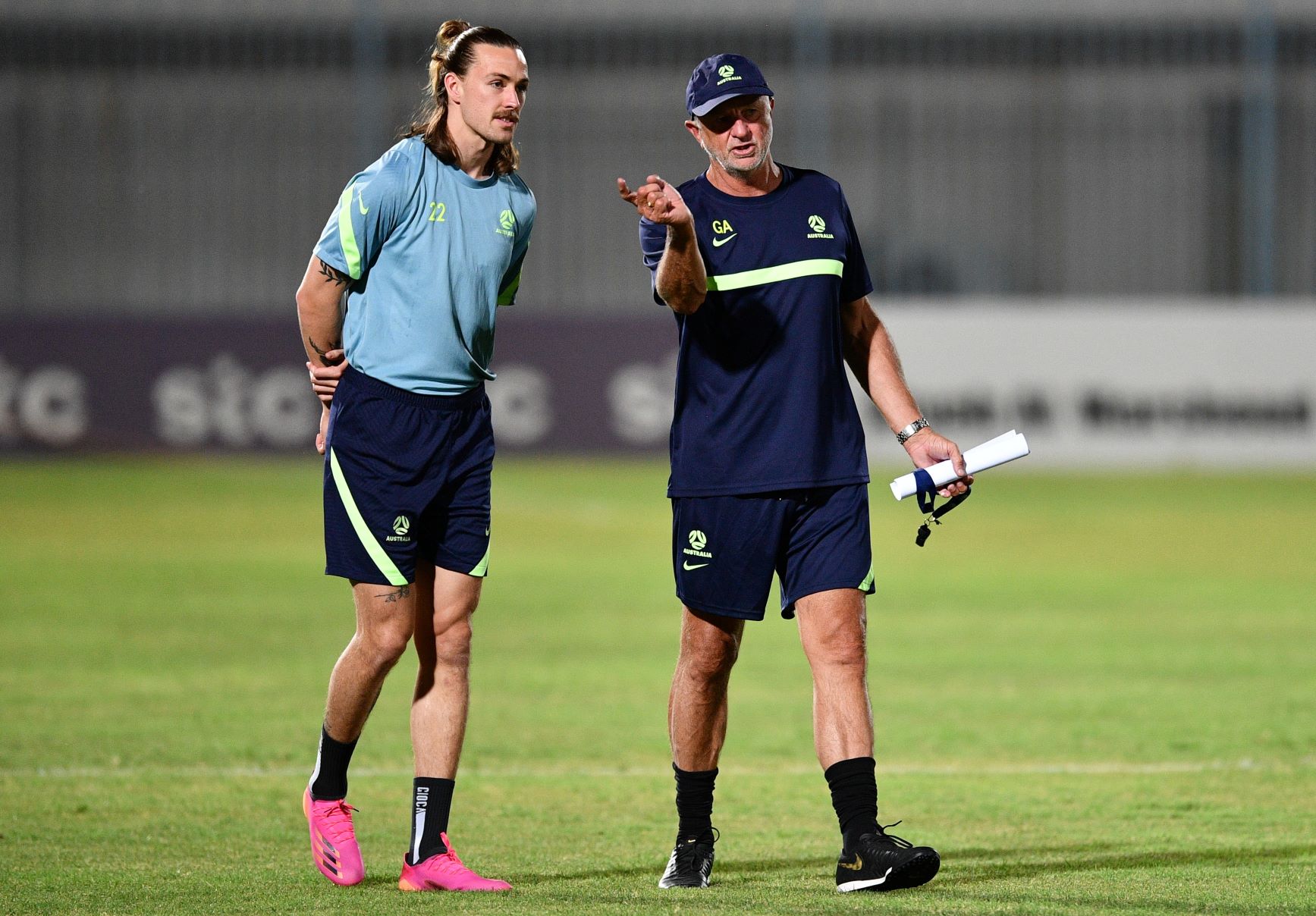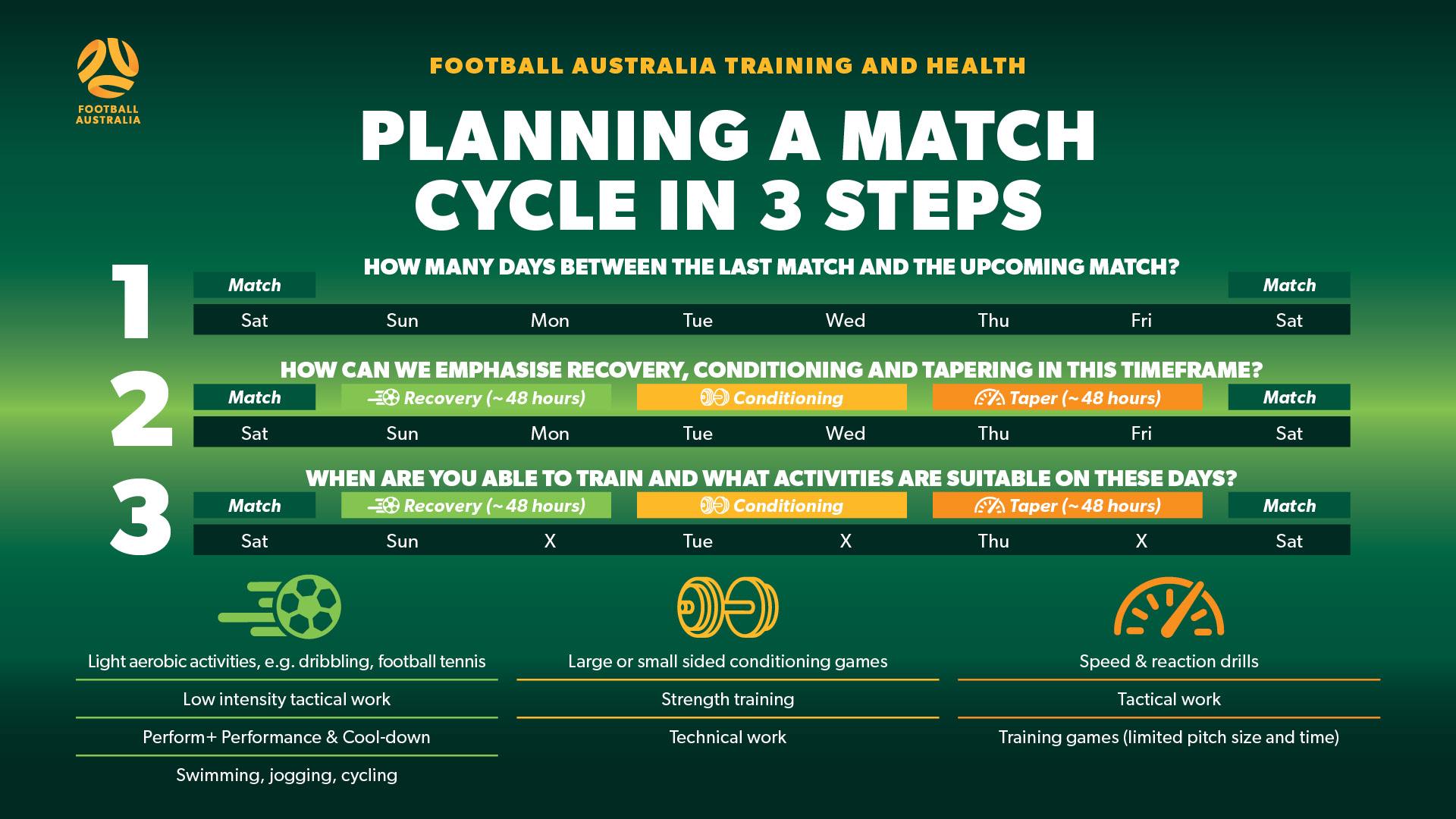PERIODISATION
Periodisation describes the systematic planning of training programs with the aim of maximising training gains and achieving optimal performance in matches [1].
Periodising training usually involves dividing an entire training year (or longer) into smaller phases and cycles, ranging from match cycles lasting a number of days, to meso (or middle) cycles lasting several weeks, to different phases of the season, like pre-season or the competition phase.

Varying technical, tactical and physical aspects of training are then emphasised across these cycles to achieve something coaches and sports scientists call supercompensation, a positive physiological adaptation in response to a training stimulus.
Supercompensation theory states that any given training stimulus elicits a fatigue response, which decreases our preparedness to train or compete again. This fatigue response is generally related to the intensity and work we are required to do. When we allow our bodies time to recover, we adapt beyond pre-existing levels, thereby increasing our levels of preparedness [2].
Placing the next training stimulus too soon, before we have fully recovered, leads to fatigue levels increasing and preparedness decreasing. Placing the next training stimulus too late means supercompensation adaptations are lost [2]. Selecting the correct training dose and allowing for adequate recovery is therefore vital for optimising training gains.
Football is a physically demanding sport that requires speed, power, endurance and strength [3], all of which need to be periodised across a training program, whilst ensuring that tactical and physical aspects of performance are not neglected. Integrating physical conditioning into technical and tactical training is therefore vital in optimising training time, but there are many ways to periodise training and not one approach that suits all circumstances.
Understanding the needs in a cycle to recover, condition and prepare for the next match whilst challenging your imagination to integrate tactical and technical skills are the essence of successful periodisation. Designing each match cycle to fit into a season plan ensures that all players continue to improve throughout each year.
Andrew Clark, High Performance Coordinator
The infographic below explains the process of planning an in-season match cycle, when to emphasise recovery and tapering (reducing training volume to allow our bodies to be fully prepared for a match) and what training content might look like.

Periodising training for team sports such as football can be incredibly complex.
The following dropdowns will explain some of the key principles of periodisation to help you develop training programs for your team or yourself.
Stressing our bodies beyond what they are accustomed to is essential in creating a supercompensation response [2]. In other words, regardless of whether we are training speed, endurance or strength, we must sprint a little faster, run a little longer or lift a little heavier than what we are used to in order to improve our performance levels.
In practice, this means manipulating our training loads, a product of training intensity and volume, from week to week to ensure we are continually adapting. For example, small sided games (3 v 3 or 4 v 4) are an excellent way of training our ability to repeatedly perform high intensity actions. If players can complete four sets of 2 minutes with 1 to 2 minutes rest, they should complete an extra repetition the following week and then again the week after, before eventually increasing the time of the repetition itself from 2 to 3 minutes. In this example, relative exercise intensity remains constant (although players will be able to perform more actions per 2 minute block), but training volume increases from week to week, thereby ensuring progressive overload.
If training loads are not adequately progressed throughout the training year, players will stagnate or even lose adaptations [2].
Many forms of physical training elicit gains in performance across other components of fitness. For example, a young footballer cycling or swimming in the off-season will improve their endurance and leg strength, which will help them cover ground on a football pitch, although it will not lead to improvements in their ability to sprint or change direction at speed, as cycling and swimming do not target these qualities.
This “transference” effect is usually high in untrained athletes, but elite athletes require more specific training to achieve desired training adaptations [2]. In football, this means that training elite players must mimic the demands of the game. The easiest way to achieve this specificity is by incorporating conditioning work into tactical drills or vice versa. Again, small sided games (3 v 3 or 4 v 4) are great examples of drills that overload technical, tactical and physical components of match play. Large sided games (8 v 8 to 11 v 11) typically require less high intensity actions but allow players to overload high speed running and running at maximum speed.
Additional conditioning training, e.g. “top-up running”, should be specific to the needs of individual playing positions and players’ roles in the team.
No two players are alike and the effectiveness of a training program on an individual depends on a host of factors, including their training history and genetics [2]. Some players are categorised as a distinctive type of player – the central midfielder that can run all day or the explosive winger that can outsprint anybody – and our physical make-up should influence the way we train.
A needs analysis can help you individualise your training: Compile a list of key physical attributes required to play in your position and your team with your coach, then rate yourself across these attributes to see where the biggest discrepancies are. Make sure these areas are emphasised across your training cycles and continually rate yourself throughout the season to ensure you feel like you are improving.
Exercise testing is a fantastic objective way of adding to this needs analysis and ensuring your training program works for you.
Recovery is essential for training adaptations to occur [2], but striking the right balance between training and recovery is not always an easy task. Many factors affect how long our bodies need to recover, including fitness status and training focus [2] [4], but school and work stresses or family life can also play a major role, particularly for non-professional players.
Remember that good nutrition and sleep habits allow us to recover as quickly as we can [5], but how we periodise our training is equally important. For example, scheduling heavy load sessions on consecutive training days within a match cycle can lead to excessive fatigue and it is good practice to vary physical emphases from day to day to allow our bodies time to recover from one training stimulus while focussing on another.
Another way to emphasise recovery is to ensure that cycles in which loads are increased from week to week should end in an unload week, where training intensity is maintained, but volume is decreased by roughly 50%. If a training cycle leads up to 6 repetitions of 2 minutes of small sided games with 90 seconds rest, the unload week should be 3 repetitions of 2 minutes with 90 seconds rest. Loads can then be increased again the following week.
Suggested Reading
- The Science for Sport website provides an overview of what a needs analysis can entail and how it can potentially help you.
References
- I. Mujika, S. Halson, L. M. Burke, G. Balagué and D. Farrow, “An Integrated, Multifactorial Approach to Periodization for Optimal Performance in Individual and Team Sports,” International Journal of Sports Physiology and Performance, vol. 13, pp. 538-561, 2018.
- D. Gordon, Coaching Science, Exeter: Learning Matters, 2009, pp. 98-101.
- G. Gatz, Complete Conditioning for Soccer, Champaign: Human Kinetics, 2009.
- M. Nédélec, A. McCall, C. Carling, F. Legall, S. Berthoin and G. Dupont, “Recovery in Soccer Part I – Post-Match Fatigue and Time Course of Recovery,” Sports Med, vol. 42, no. 12, pp. 997-1015, 2012.
- M. Nédélec, A. McCall, C. Carling, F. Legall, S. Berthoin and G. Dupont, “Recovery in soccer,” Sports medicine, vol. 43, no. 1, pp. 9-22, 2013.


